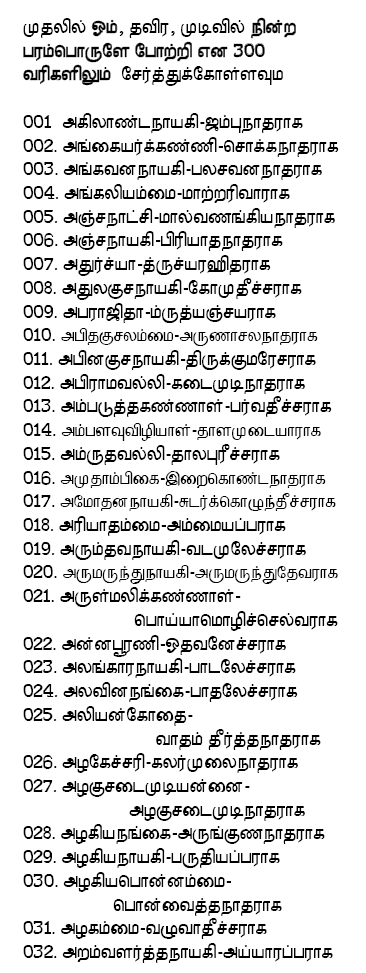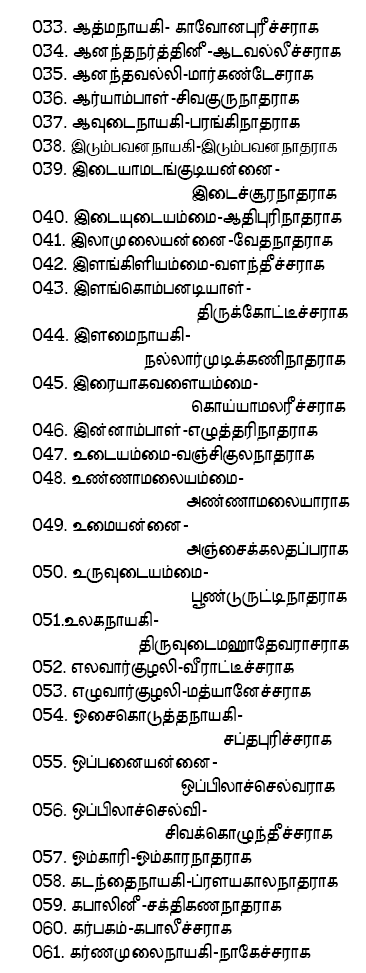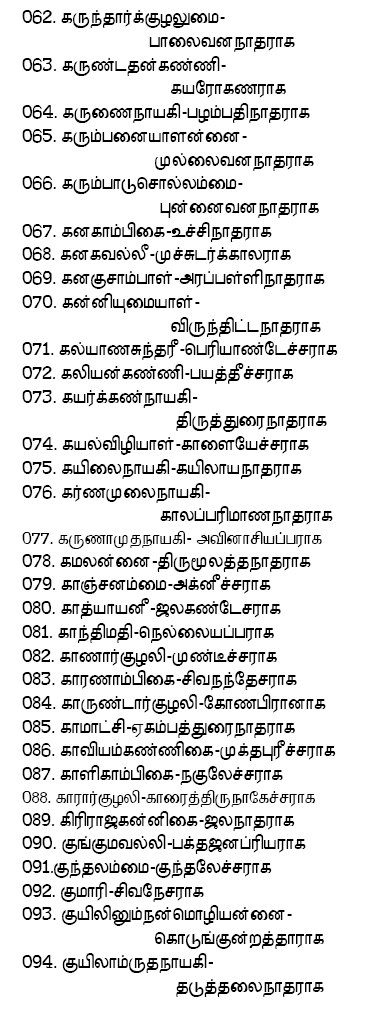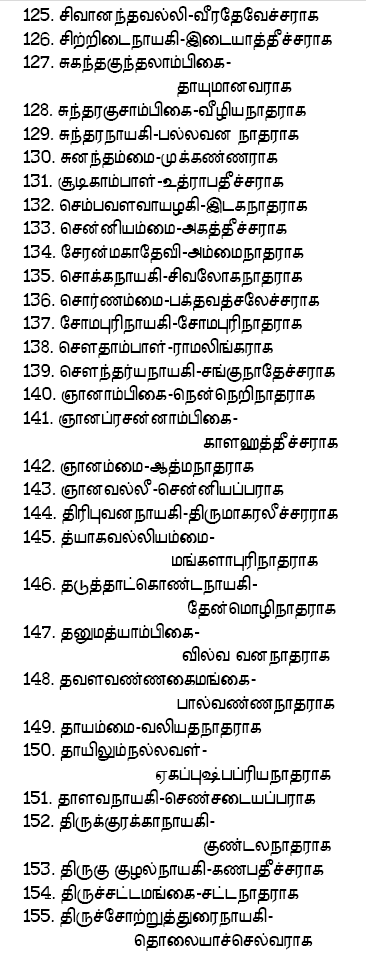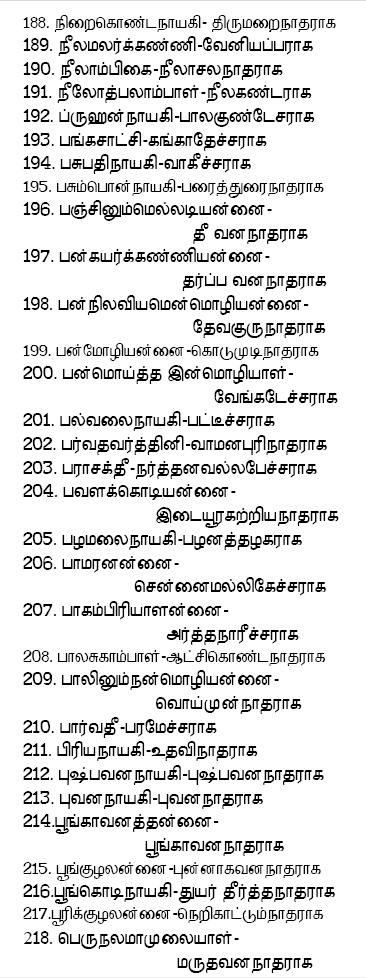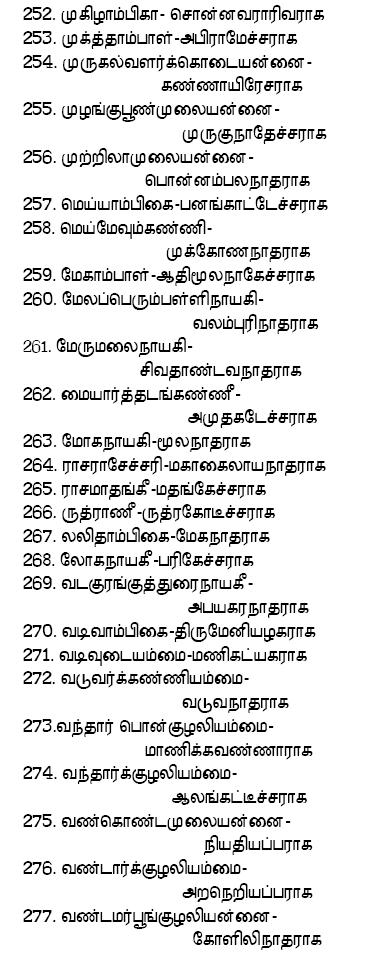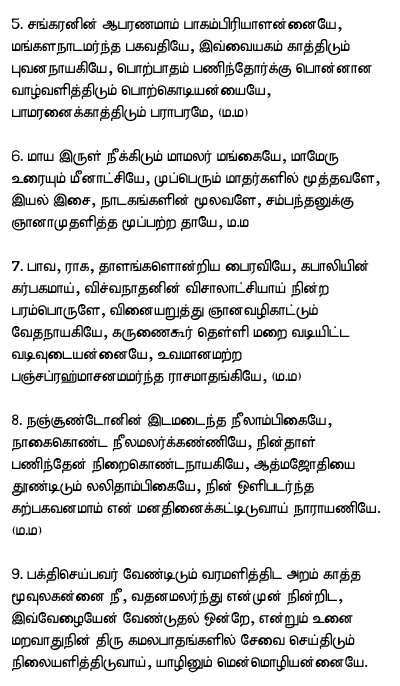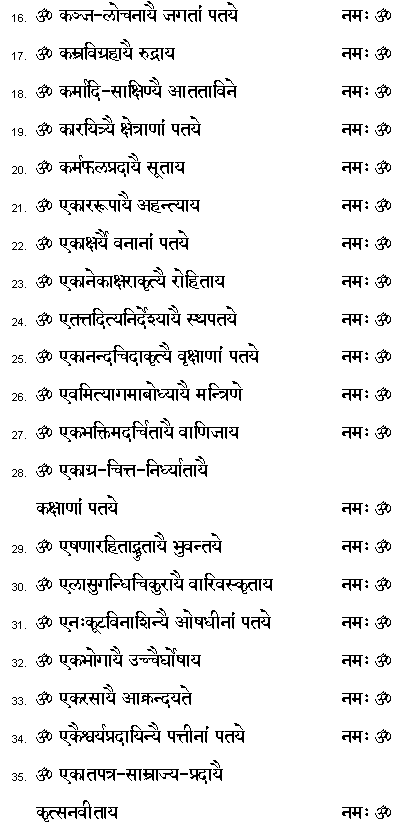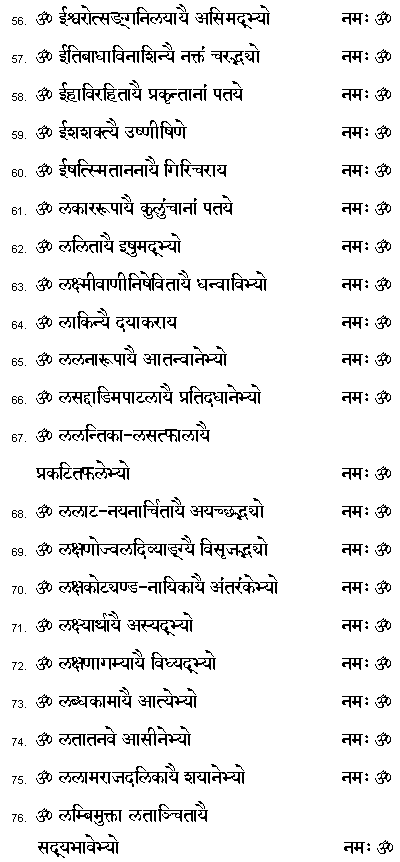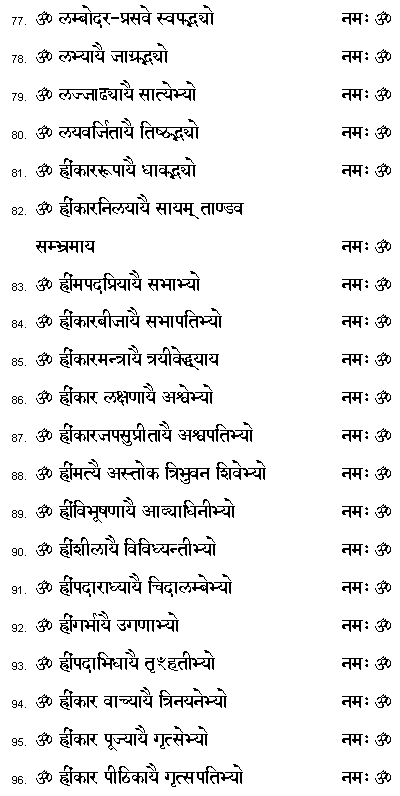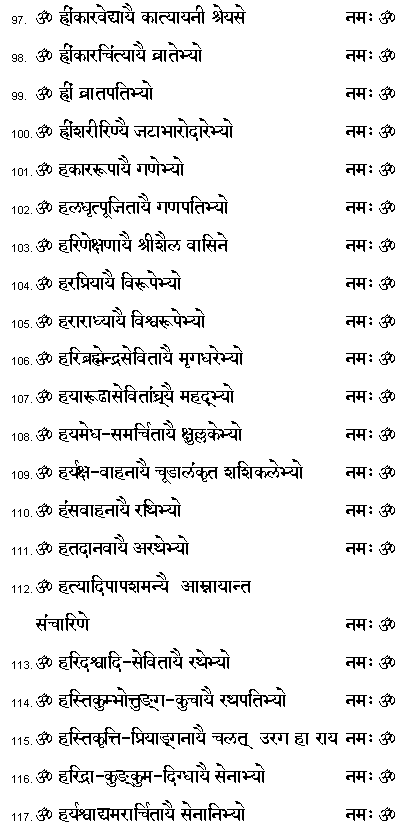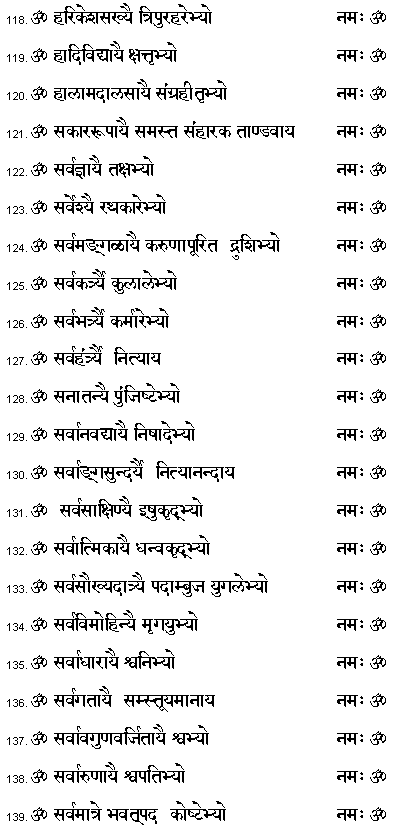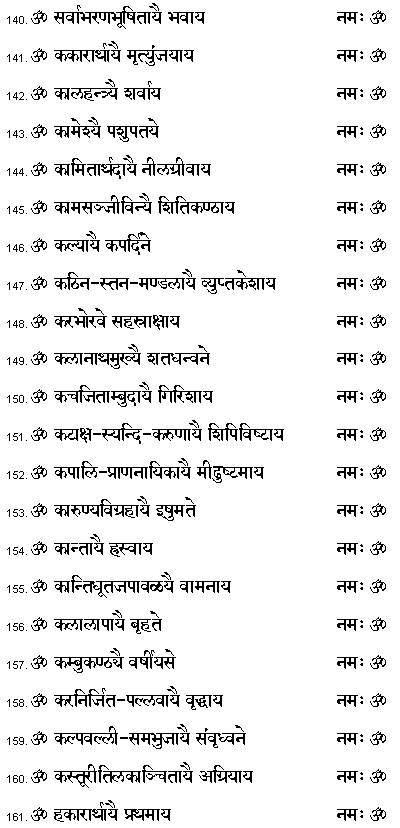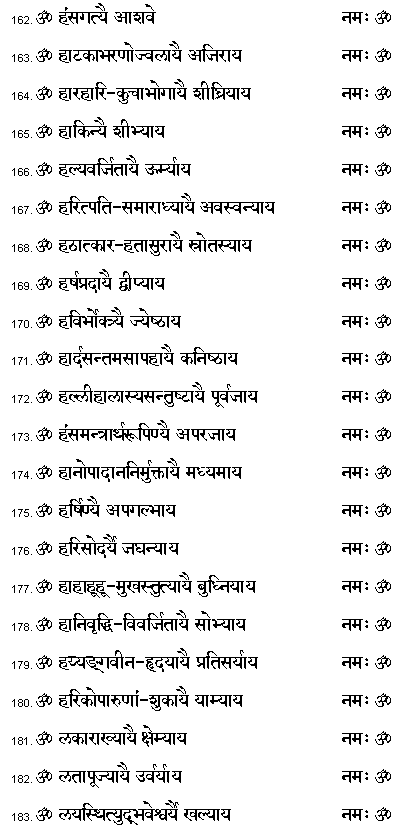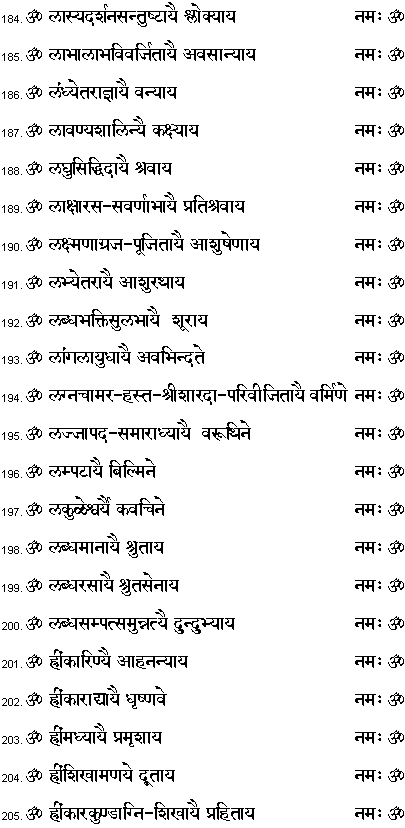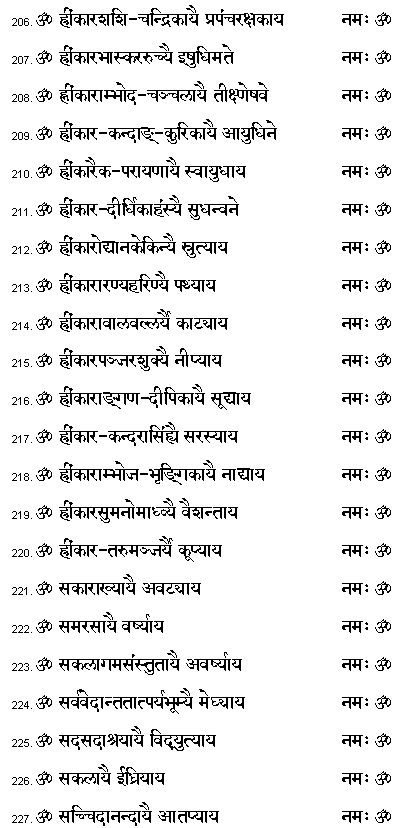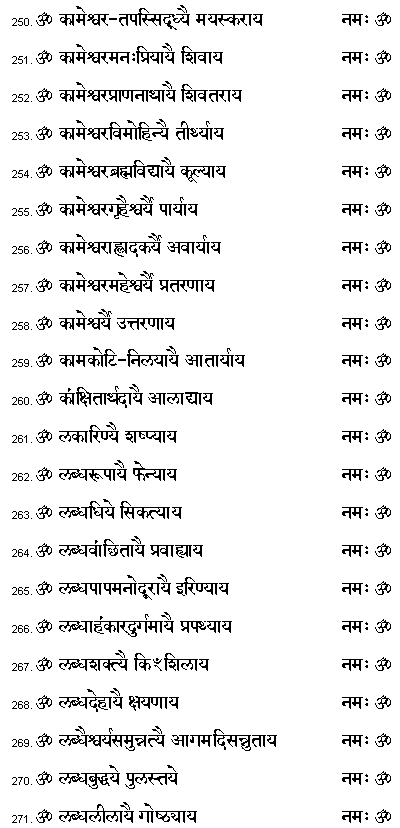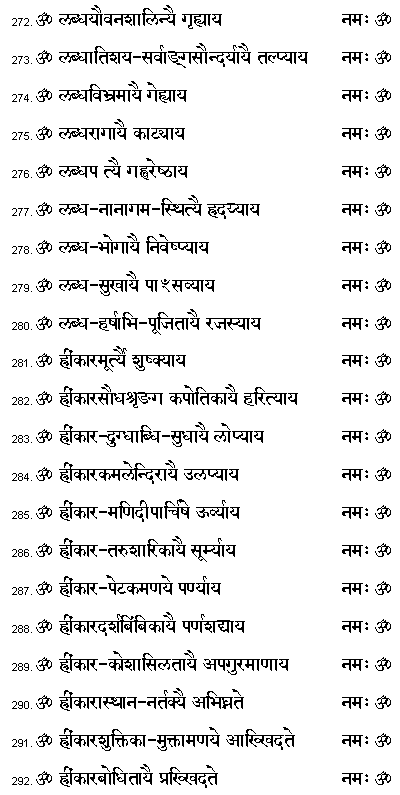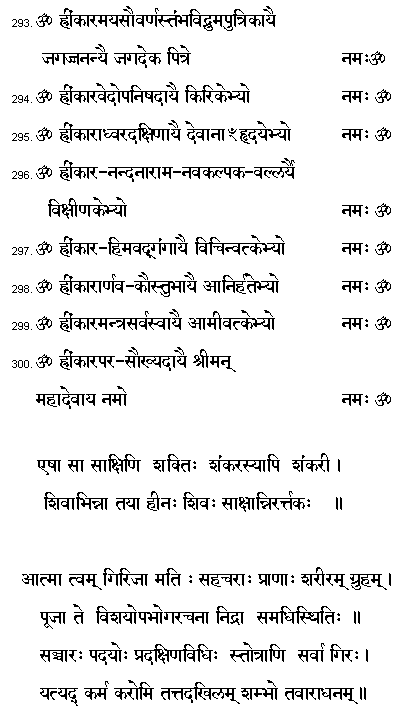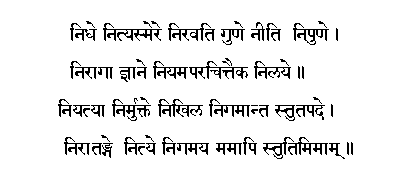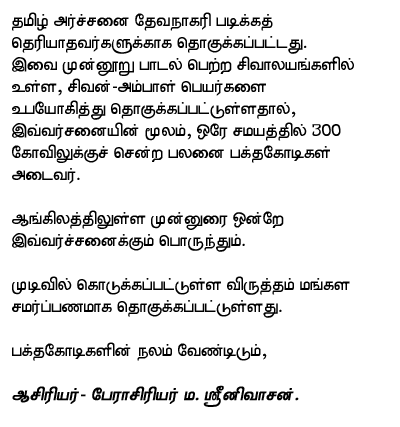
Sunday, October 28, 2007
Monday, July 30, 2007
Introduction
The Ardhanareeswara Trisadhi presented here is more a formulation based on traditional principles and mostly derived from Lalitha Trisati and Rudram. However some 34 namavali are original reference to the Lord composed based on the inner meaning attributed to the Lord by Greats like Jagad Guru Adi Shankara and Muthuswamy Deeshidar’s Kritis.
The formulation was originally made as Siva-Sakthi Sadsathi and presented as Offering at the Siva Vishnu Temple, Washington DC on January 15, 2002 during Maker Vilakku Puja in the Lord Iyappan Sannidhi.
It was then slowly integrated as Ardhanareeswara Trisadhi with the incorporation of The 34 Namaas refered to in the 1st Para.
Sanskrit 99 with itranslator 99 has been used Devanagiri. Sanskrit 99 are downloadable From web. If we click on google for these, the same will be accessible.
It is my duty to place on record my gratitude to Pujya Sri Sri Paramarthananda Saraswaty for his time and useful suggestions to improve the formulation.
It would have been impossible to bring it to the present form but for the Editorial help and correction rendered by Sri S. Srinivasan, Chairman and MD., SRA Systems.
The Tamil settings on PC was done by Rajamani Muthuswamy and Sanskrit by Ganesh Srinivasan and Bharathi Ganesh. Their help is appreciated.
Oom Namo Ardhanareeswaraya Nama: Oom.
Dr. M. Srinivasan
Preface
1. Ardhanareeswara
The Shiva-Lingam is a symbol of Lord Shiva. When you look at the Lingam, your mind is at once elevated and you begin to think of the Lord. The word Lingam is derived from the two Sanskrit words laya (dissolution) and agaman (re-creation). Thus, shivalinga symbolizes that entity in which the creation merges at the time of dissolution and out of which the universe reappears at the beginning of the new cycle of creation.
Thus, it is Shiva the destructive form of the Almighty, who is represented by the Lingam or Mark, which is manifestly the CREATIVE power of Divinity, the divine symbol that is utterly sublime Light (Jyoti) in its philosophical underpinnings.
One of the 64 manifestations of Shiva - the man-woman form with Parvati constituting the left half of Shiva is Ardhanareeswara. This is a much-hailed form in scriptures of various languages.
Mother Shakthi once propitiated Lord Shiva with such fervent intensity that she be part of him in body and mind. Her pleased husband through his divine powers granted her this wish. The Master then absorbed her in half of himself and thus was created the half-man half-woman aspect of Lord Shiva, symbolizing the oneness of all beings. One can state that even In Gender definition, this aspect became the fundamental root of Advaitha.
This fusion of Shiva and Shakthi representing the male and female halves transcends the distinction between and limitation of male and female and takes the Lord to the level of beyond-gender manifest Brahman, realization of which means liberation.
Shakthi part is golden, while Shiva part is snow-white. She is substrate and He is substance. Shiva is static; Shakthi is dynamic and creative. Shiva is Being and Shakthi is Becoming. He is One; She is many; He is Infinite and She renders the Infinite into finite; He is formless and She renders the Formless into myriad forms; but both are one. Shiva and Shakthi exist in Nirmala Turiya state (Stainless Purity).
When it comes to worship of Ardhanareeswara, some worship the Shiva aspect and some worship the Shakthi aspect. Shiva is viewed as the Holder of Power, though he is inert. Shiva is Shava (dead body) without Shakthi. All that power in creation, maintenance, and dissolution rests with Shakthi. But the Great Mother does not exist without Shiva. When they become one, Ardhanareeswara becomes, a being of generative and constructive force.
Philosophically, this form portrays the boundless Grace of God. The formless God is called parashiva. On Its own free-will for the benefit of pashus (souls), which are drowned in pAsha (bondage), It thinks to create the worlds. Its dynamism of creation thus springs out of It, which is called Shakthi. Now Shiva and Its power Shakthi create everything. This is the form of their togetherness that makes every existence active. Shiva and Shakthi are one and the same Supreme may also act independently. They are associated like the person and the action of the person. They are one and the same like the ice and the water - one becomes the other. Poet Kalidasa hails them as inseparable like the word and its meaning, the letter and pronunciation!!
“vAk arthA viva samprakthau vAkartha pprathipathayae jagatha: pithrau vandhe parvathi parameshwarau “
From time immemorial the man-woman relationship has always dominated the very fabric of civilization. Whether it is the western theory of creation, that of Adam and Eve, or the Indian concept of Purusha and Prakriti, the very core of civilization stems from the concept of the union of the male and the female.
Shiva and Shakthi are compared to gold and gold ornaments; they are same; Shiva is hypostasis and when this force fuses with Shakthi results in multitude of manifestations.
Legends:
We find many references in our ancient puranas, regarding the origin of this Supreme form. Brahma the creator of the universe, crafted the cosmos as per the divine instruction. He made all the living beings and yet could not find any development. The beautiful world remained lifeless without any expansion. The maker was very much worried. A heavenly voice instructed him to commence creation with the help of copulative activities. But Brahma was finding it impossible since all the forms had been inert (males) till then. At this instance the supreme form of Ardhanareeshwara manifested. Brahma contemplated on this form of Shiva - Shakti. The Lord became very pleased with him revealed his Ardhanari form- Left side of his body resembled like a woman while the right side appeared like a man. Lord Brahma worshipped this form of Shiva and the Lord then separated the feminine part of his body and thus manifested mother Shakti. Lord Brahma worshipped her and requested to bestow such power by which he could create a woman. Goddess Shakti blessed him by saying - 'So be it' and vanished. This way Lord Brahma became capable of commencing copulative creation. It was only then that Brahma realized his mistake and created a woman, and Srishti or creation began.
In another episode, Goddess Umadevi once playfully closed the eyes of her beloved, which plunged the world into darkness. All living beings suffered in the dark. The universal mother felt for her folly and separated herself from her companion. Mother started worshipping Lord Shiva in the form of Linga to absolve herself of this sin and to reunite with him. Lord Vishnu, (or Adi Kesava Perumal, enshrined at Thiruchenkode, a unique Ardhanareeshwara temple) instructed Shakthi on the Kedara Gowri Vratam to be performed to unite with Shiva. When she reached Kancheepuram, Lord Shiva ordered her to proceed to Thiruvannamalai and do her penance. Likewise Mother Parvathi did penance at Pavalakundru with the help of Saint Gowthama. A demon called Makishasuran disturbed the penance of Mother Parvathi. The Mother took the form of goddess Durga Devi and destroyed him on the full moon day of the Tamil Month of Karthigai during the auspicious period of pradosham. Lord Shiva presented himself in the form of Fire atop the hill and merged Goddess Parvathi on the left half of his body. This day of Supreme merger is celebrated as Karthigai Deepam. To commemorate this event, every year during the festival of Annamalai Deepam, Lord Arthanareeswaramurthi presents himself as Jyothi Swaroopa to his devotees.
Another famous anecdote of Ardhanareeshwra is related to Sage Bringi. Sage Bringi was one of the ardent devotees of Lord Shiva who considered that Shiva grace is the ultimate source for existence. He was a violent votary of Lord Shiva to the exclusion of any deity in the worship including Parvathi! He refused to worship Shakthi, a woman. Even during his daily worship, he would circumbulate only the Lord ignoring Mother Shakthi, with a flashing spark of arrogance. The divine couple wanted to enlighten the sage and hence assumed this unique form sharing his body with Parvathi. The couple took the form of Ardhanareeshwara and stood unified inseparable to every atom. Even then the egoistic sage took the form of a bee (Bringa in Sanskrit stands for Bee and the sage came to be called Bhringi.) and tried to pierce through the body of the Lord so that he could go around only the Shiva part. In every human body the static force of Shiva constituted the bone and the skin and the dynamic force of Shakthi triggered the blood and flesh. Goddess Shakti, being the power as the name indicates, pulled out her energy from Bringi's body. Now he was a mere skeleton and was even unable to stand. The Lord pacified Parvathi and gave the sage one more leg to stand. The sage soon realized his folly and understood that life becomes dynamic only by the blending of both grace and force which are not contradictory but complementary to each other.
At this point, instead of getting deeper into the analysis of the beliefs of different Schools on Saivism [one can read the writings of Swami Tapasyananda, RK Mutt, for greater details], going to the basics of Advaitic Philosophy of AdiSankara, the following leads to Ardhanareeswara.
The Supreme Reality is non-dual, having within it, a distinction between Shiva and Sakthi – the Power holder and Power- described as Being and will. What is called Power becomes the Mother, Tripurasundari and the Power Holder, Shiva Her Concert. Thus though they are one in principal, in practice they are treated as distinct. Thus it ca be said, Shiva Lingam encompass both the aspects and become the Root of Ardhanareeswara.
Ardhanareeshwara stands for a profound philosophic truth that the female and the male are complementary to each other and it is their combination, the blending of grace and force that contributes to the creation of life.
The serene Kumudakriya raga and its flow in the kriti Ardhanaareeswaram By Muthuswamy Deeshidar, provides the appropriate background for a narration describing Tiruchengode and the shrine to the Ardhanareeswara form of Shiva - a shrine where the last puja of the night is of special significance.
This song by itself is easily understandable for its inner meaning, - more specifically the charanam in praise of the Lord. Many of te other songs By Muthuswamy Deeshidar at Various Siva Temples on the Lord and Devi, though sound as if written on Lord Siva or the Supreme Mother, a deeper understanding will show that most of them bring out the Oneness Of the Supreme- the Ardhanareeswara.
As examples the author would like to site only two songs:
The song Thiagarajayogavaibhavam in AnandaBairavi
tatvaswarupa prakasam sakala tatva swaupa prakasam sivasakthyaadi
sakala tatva swarupa prakasam
the teacher of the nature of philosophical truth (tatvaswarupa praksam), known by all the different religions (sakala tatvaswarupa prakasam), and in the form of Siva and Sakthi (potential energy and active power) which is the basis of every thing.( sivasakthyaadi sakala tatva swarupa prakasam).
The 2nd song is the Neelayadakshi in Neelambari.
Siva Kaayaa Rohanee Sollasini Chitrupa Vilaasini
She delights in sharing half the form (“kaaya”) withLord Shiva and shines (“rohane”) as supremeconsciousness. (“sollasini”).
To summarize subtly for the understanding of the layman about Shiva:
He' Paarvathee Hrudhayavallaba Chandramoule'
Boodhaathiba Pramadhanaadha Girisavaasa
He' Vaamadhe'va bhavarudhra Pinaakapaane'
Samsaaradh:ukkaka Hanaath Jadheesa Raksha
The concept of the Hindu Trinity, establishing Brahma as the creator, Vishnu as the preserver and Siva as the destroyer was taught to the simple peasants by the Rishis.
Shiva is sometimes depicted as fiercefull god with terrifying weapons and frightening face. In fact Shiva is not at all firecefull or frightening and this fact can be understood while we have an in-depth study of Vedas and Upanishads. Shiva is very merciful and loving in nature. He always gives his devotees whatever is asked for. He is the one who gave immense powers to Ravana, Surapadma, Tharasura and many more assuras. He is muscular while fighting with evils and that is why he is called the Destroyer of evils. He is feminine while gracing his devotees with love and that is why he is called Thaummanavar. He is the male and He is the female. He is the Shiva and he is the Sakthi. Without Shiva there is no Sakthi and without Sakthi there is no Shiva. The Shivaskathi Concept is enshrined in Ardanareeswar where we can see our mother in the left and our father in the right. An iconographical and textual depiction of Siva, which epitomizes this dynamic most powerfully, is through the figure of Ardhanareeswara.
Ardhanareeswara´s iconographical embodiment of paradox and the meeting of dualities-embodied sonically as well as visually-mirrors a similar paradox and synthesis embodied by individual men and women. The male hormone Testosterone in women and the female hormone Estrogen in men testify to the fact that characteristics of both sexes are present in each one of us. The production of these in our bodies keeps our personalities and our bodies in balance. The differences are brought together in the beautifully conceived anthropomorphic form of Ardhanareeswara. The form encompasses every thing from action to inaction, eternal rest to endless activity, the terrible and the benign. The Devi depicted on the left half of the deity, is the power of god by which creation, protection, and destruction of the universe is accomplished. The philosophy of the Ardhanareeswara places the genders on equal terms without question.
2. The Basics of the Yantra and the significance of Srichakra & Maha Meru.
In Ardhanareeswara Puja.
Sri Yantra / Maha Meru is the mystical construction of cosmos, and have the power of 330 million Mantra-Devatas (subtle-energies) polarized and embedded therein, in the form of 52 Matruka Aksharas (alphabets) which form the base of any Mantra, its attributed Deity, the carriage (Vahana or vehicle on which the Deity sits), the herb or tree to which it belongs and the corresponding body part of the human beings, which it controls. Therefore Sri Yantra / Maha Meru represents the whole Universal Energy and the Energy embedded in every animate and inanimate objects, meaning the Soul.
Before starting the worship it is advisable to know about the way the Sri Yantra is constructed, what all it represents, about the 9 Avaranas, the deities, their gunas and significance, so that your worship is more meaningful. The following are the authentic details as given in various Tantra & Mantra scriptures.
Five downward pointing triangles representing Devi intersect with four upward pointing triangles representing Shiva, forming 43 triangles including the central triangle.
From the five Shakti triangles come creation and from the four Shiva triangles come the dissolution. The union of five Shaktis and four Fires causes the chakra of creation to evolve.
At the center of the Bindu of the Sri Yantra is Kamakala, which has three Bindus. One is red, one is white and one is mixed. The red Bindu is Kurukulla the Female form, the white Bindu is Varahi the Male form, and the mixed Bindu is the union of Shiva & Shakti - the individual as the potential Sri Chakra. Varahi, the father-form, gives four dhatus to the child and Kurukulla, the mother-form, gives five dhatus to the child. Theses represent the nine dhatus of the human body. Varahi's four fires are the 12 (4 x 3) sun Kalas, the 12 Zodiac constellations. Kurukulla's five triangles are the 15 (5 x 3) Kalas of the moon, 15 lunar Tithis.
These nine triangles also represent the nine stages of growth of the human child in the womb. Surrounding the 43 triangles formed by the intersection of the nine triangles are the 16 petals circle. Surrounding the 16 petal circle is an 8 petal circle. After that the 3 lines and at the outermost part of the Sriyantra there are 3 lines called the Bhupura.
The 43 triangles constitute the six inner sections called Avaranas, the two circles of petals are two more avaranas and the Bhupura of 3 lines is the last Avarana. These 9 Avaranas of the Sri Yantra have various presiding Devis. They are the Devi's Parivar (retinue) of total 108. In the Srichakra puja they are systematically worshipped one by one with their names and mantras. The presiding Deity of Srichakra, Devi, is Known as Lalita Tripura Sundari. The form of Devi Kamakshi of Kancheepuram is the closest resemblance of the Devi as described in the scriptures
Chakra puja or Yantra puja is the worship of a deity in a diagrammatic form. This type of worship exists in a lot of the other parts of the world also. The worship of Devi in Sri Chakra is regarded as the highest form of the Devi worship. Originally Lord Shiva gave 64 Chakras and their Mantras to the world, to attain various spiritual and material benefits. For his consort Devi he gave the Sri Chakra and the highly coveted and the most powerful Shodashakshari mantra, which is the equivalent of all the other 64 put together.
The Bindu in the center of the Sri Chakra is the symbolic representation of the cosmic spiritual union of Shiva and Shakti. Apart from that the Sri Chakra also embodies countless number of deities and represents the whole of creation. Hence by worshipping the Devi in Sri Chakra one is actually worshipping the highest ultimate force in the Tantrik form. That is, the Upasaka is worshipping Sri Ardhanareeswara [ri] at the Bindu.
Lalita means The One Who Plays. All creation, manifestation and dissolution is considered to be a play of Devi. Tri-Pura means the three worlds and Sundari means beauty. She is the transcendent beauty of the three worlds. Tripura also signifies: - She is the ruler of the three gunas of Satva, Rajas and Tamas; and Sun, moon and fire - the zodiac and the planets, and therefore Time itself; She is also "tripura" as Will (Iccha), Knowledge (Jnana) and Action (Kriya). She is also "tripura" as intellect, feelings & physical sensation; and She is triple as the three states of the soul - awakening, dreaming and -sleeping states. Her five triangles also represent the Pancha Tatwas and the Pancha Bhootas. (This is what the verse in Lalita Sahasranama means by -"Panchami pancha bhuteshi pancha Sankhyopacharini ". It is difficult to say what She is not. Lalita holds five flowery arrows, noose, goad and bow. The noose represents attachment, the goad represents repulsion, the sugarcane bow represents the mind and the flowery arrows are the five sense objects.
It is important to note that the Sri Yantra / Maha Meru is placed, with the central triangle always pointing down or towards the sadhaka (worshipper). In the Meru the central dot is within a triangle and here also any point of the triangle will always face the worshipper. Whatever side the central triangle faces, it becomes south and the top becomes North. If the Sri Yantra is placed with the 5 triangles looking down, it becomes the Sakthi Chakra (potent energy) and if it is placed with the 4 triangles looking down, it becomes the Shiva Chakra (latent energy). In the case of Maha Meru, it is never placed lying flat down, as it is conical and will always be placed top up. Therefore they have no sides such as North, South, East or West etc.
The north-east of the Sri Yantra / Maha Meru is the place of Agni, the North West Divine (God), the South East - Asura (Demon negative), and the South West Vayu air flow. Therefore they totally control the flow of energy in the puja room or meditation hall or house or office wherever it is placed and brings in all benefits to the user. It corrects the aura of the individual's magnetic field, cleanses the place of unwanted energy, corrects vastu defects, increases happiness and contentment and finally helps one to reach the goal of human life. It ushers Spiritual and Material benefits to go hand in hand.
The subtle energy in Sri Yantra / Maha Meru will not vibrate unless it is properly charged and given the power by the process of transmission of Divine Energy by the competent persons, much like the human body, which cannot vibrate without the soul. Extensive bathing with sanctified water, performing Puja (worship) charging the Sri Yantra and Meru with Divine Mantras prescribed, and finally doing Homa (havan) in sacrificial fire are all done as prescribed perfectly.
Why a Meru inside a pyramid or cube? The angular measurements of the Pyramid correspond to the angles in Sri Yantra / Meru. The Pyramids give out bio-energy fields, akin to those found in ancient Sri Yantra installed in various Temples in India. Temples where the Sri Yantra / Meru is installed provide the bio-energy to cure the illness of those who rested there. Therefore a combination of Meru inside Pyramid/Cube was conceived to double the effect of reducing illness, bringing in harmony, prosperity and peace of mind.
Worshippers of SriChakra or Mahameru vibrate Divine energy and are able to transmit the same to others for the welfare of the society. There are nine chakras in the Sri Chakra. These nine Chakras have each a distinct form and a distinct name. Proceeding from the outermost to the inner, let us describe the Chakras. The outermost is a square Chaturasra of three lines, the lines one inside the other, opening out in the middle of each side as four portals. This is known as the Bhupura, the earth-stretch. This is the ground-plane if Sri Chakra is considered as graded elevations, Meru. Through the portals in the Bhupura one enters the precincts. Immediately inside the square are three concentric circles, which serve as three girdles trivalaya. The space between the sides of the square and the circumference of the outermost circle, between Bhupura and Trivalya, is known as Trailokya Mohana Chakra, the Enchanter of the Triple World. Inside the 3 girdles are: 1. Sarvasa Paripuraka Chakra - 16 Petals - Fulfiller of all Desires; 2. Sarva Sanksobhana Chakra - 8 Petals - Agitator of all; 3. Sarva Saubhagyadayaka Chakra - 14 Triangles [Chaturdasa Kona] - Giver of all Auspiciousness; 4. Sarvartha Sadhaka Chakra - 10 Triangles [Outer Dasara] – Accomplisher of all Purposes; 5. Sarva Raksakara Chakra - 10 Triangles [Inner Dasara] - Giver of all Protection; 6. Sarva Rogahara Chakra - 8 Triangles [Ashta Kona] - Remover of all Diseases; 7. Sarva Siddhiprada Chakra - Inverted Primary Triangle - Giver of all accomplishments and 8. Sarvanandamaya Chakra - Bindu – Full of all Bliss.
The Mahamehru is consisting 43 triangles. The base is having 4 door opens which are called Dhwara Shris and the next step is consisting 3 circles which are called as Bhoopurams and the next is 16 petal lotus and the next is 8 petal lotus and the dot is called as Bindustanam. In that Bindustanam, the goddess Parasakthi is being seated in 4 legged simhasanam in the lap of her husband Kameshwara. The puja method of this Mahamehru is called as Navavarna puja.
According to ancient rishis and saktha upasakas where the "Maha Meru" is kept (i.e., Sri Nagara of Goddess Parasakthi) it is sure that the three supermost powers namely Parasakthi (to give us strength), Mahalakshmi (to give us a very good wealth) and Maha Saraswathi (to bless us with vast knowledge and education) will have their permanent residence.
As per the mathematical theory, Mahameru is of 90 Deg. and its shadow will be only inside of it. In India, the Chola King Rajaraja Cholan made the Sikaram in Sri Prahadeeshwarar temple at Tanjore District according to this theory.
The mention of the geographic location of Mt. Sumeru in Vishnu Purana is very interesting. Most significantly, Kailas Range is situated at 31.00 N 82.00 E while Mt. Everest is at 28.05 N 86.58 E. Both the peaks are close to the centre of the earth (90 degrees). Thousands of years ago, the maharshis could realize that the Mount Sumeru is at the centre of the earth.
Bhaskararaya’s bhashyam for Lalitha Sahasranamam while dealing with the Naama “Mahameru Nilaya” quotes that the Book, Tantraraja Chapter 28.
“In the midst of Meru the great shining Lalitha ever remains”,
around it (the meru) there are 14 continents up to the ocean where the other deities (remain).
Beyond them in the last supreme ether are, abodes of Chitra’s and the other deities. Sri Chakra has 3 aspects: Bhoomi, Kailasha and Meru. When it is identified with the eight deities namely Vasini and others it is the Bhuprastara; when it is with the matrika letters it is Kailasha; and the Meru when it is with the 16-nitya deities. Meru nilaya means She abides in the mental identification with 16 nitya deities. Meru, the nine-syllable mantra as described in the gyanarnava indicated by the following words:
“ Bhoomi Chandra Shiva Maya Shakthi Krsnadhavan Madhana Ardhachandra and Bindu.” Nilaya the place where from all other mantras arose.
Mahameru Puja and its inner meaning.
The significance of Mahameru Puja has been well explained by People like Anna Subramanya Iyer, Kalyanasundaram Iyer , Najan Publications and others. The following is the underlying significance Of the Puja which must be a daily Ritual- for true enlightenment. The person doing Puja it is said , is synonymous with the Supreme mother and with true surrender and sincere devotion to his duties , one integrates with the Ultimate.
One starts with Todi, then MahaGanapathi, Balasubramanya followed by the 10songs and to does Lalitha Sahasranaamam and or Trisadhi.
Here after singing Todi, the upasaka gets the blessings of Devi to do The ULTIMATE PUJA and for that seeks and gets Permission from HER and the 32 Rishi's/Sidhhas who are ever in Her Service at the 1st step of Shri Mahameru.
Then he goes one step up on Mahameru Anticlockwise[ACW] =Appradakshinam to get the blessings of MahaGanapathi[Gowlai song] and 24 sidhhas,at the Banks of Kamalaalaya Theertham .After having the bath the upasaka climbs 2 more steps, again anticlockwise to get the blessings of Balasubramanya[suritti].
Balasubramanyar is Siva Guru and with him are 16 Rishis at this step. Proceeding ACW while singing Ananda Bairavi, asking MahaTripura Sundari to "Protect me": Kamalamba Samrakshithoham"! One also gets to be blessed by 16 sidhhas at this point.
According to writings by Greats, an average human is indeed blessed very high to reach, even this step with all his/her worries, aspirations and day to day responsibilities.
Now a blessed one proceeds further ACW singing Kalyani Kamalamba seeking Her Grace to permit to worship HER "as the one always worshipped by Lakshmi and Saraswathi.” Here one is blessed by Devi and 12 Sidhhas.
After Kalayani one climbs ACW to sing Sankarabaranam "seeking HER blessings to be integrated with "Brahman"! 9 sidhhas bless the upasaka at this step.
Climbing further ACW, while singing Kamboji, one is worshipping Her as the ultimate Mother of all beings - Devaas, Rishis and Lord Siva Himself. The upasaka is blessed to get Her Grace and blessings of 6 of the Greatest Sidhhas and proceeds ACW to Sing Bairavi. The meaning of Pallavi is explicit, “I HAVE NOTHING ELSE TO CLING ONTO, except thy lotus feet-Param Nahi Re" telling her " Sivaantha Thathva Swaroopinya"= you are Siva and Sakthi”. There are 4 more Sidhhas at this level..
Next ACW climb leads to Punnagavarali Song and Sahana song, both in Her Honor telling Her, "you are the root of everything”. With Punnagavarali the upasaka gets blessed by 2 SathGurus . At the penultimate step to Bindu [Kanda Kamala]. the upasaka worships Lord Siva as the Ultimate Guru of all. Now the upasaka is at the foot of Sri
Bindu on Sri Mahameru singing "Sri Kamalamba Jayathi". The lat song is Sri Raga Kamala and one concludes with Lalitha Sahasranaamam or Trisadhi or both. The Ardhanareeswara Trisadhi integrates The Sakthi and Siva by way of Naamaas derived from Lalitha Trisadhi and mostly Rudram and will certainly help the upasaka for integration with the Supreme through True surrender.
3. What is special about Ardhanareeswara Trisati presented.
Ardhanareeswara Trisadhi is more a formulation than an Original Composition.
The 1st part of each Naamaa is derived from Lalitha Trisadhi and the 2nd part from Rudram. However of the 300 masculine Naamaas, 34 are not derived from Rudram, but from various other Scriptures set in praise of Lord Shiva since Rudra Trisadhi has only Pranava Manthram or some repeats in these 34 places. These 34 namaas as well as the entire formulation were made during Sri Mahameru Puja over several months through the direct guidance by the Supreme Mother Herself.
4. Puja Methodology.
This is a note written with all humility and total Surrender to Sri Ardhanareeswaraa for the benefit of those Uppsakas who aspire for self-realization.
Sri Sri Paramacharya and the other Greats have always emphasized on Athma Vichara while being selfless, living with no hatred and jealousy towards fellow beings.
The Mother is an integral Part of Lord Shiva and no need to look anywhere except Sri Lalitha Sahasra Naamam for getting an introduction to Shiva-Sakthi Iykkyam.
People being familiar with Navaa Varna Puja, Mahameru and Sri Chakra Puja are aware of the need of discipline and proper initiation with rigorous Anushtana approaches.
In the present day world with a fast life, the average Gruhastha has very little time for practicing even the elementary rituals.
This note is neither critical of the present day set up nor aims at imposing any specific methodology for prayer.
It is said, that to be a Devi Upasaka, one should be blessed by THE MOTHER even before the birth.
An extensive survey of Literature On Ardhanareeswara both by Goggle and Wikipedia revealed that Lalitha Sahasranaamam is the one cited for Ardhanareeswara Puja and this author could not locate a separate Ardhanareeswara Trisadhi and Sahasranaamam.
This formulation presented here is at the ordainment of Sri Lalitha Tripurasundari.
For those who may raise the question:
Shiva Sakthi uses the masculine Gender 1st while in this formulation on what basis, Feminine gender precedes Shiva Naama in each?
In all our Puja’s during Sankalpam, we say:
“Kalpakaamba sametha Kapaaliswara Swami Sannidow,
Alamelu Manga Sametha Veenkateswra Swami Sannidow and so on.
Also Without Sakthi [Energy] Shiva is Powerless. Naturally
Sakthi take precedence to Shiva, here in.
For those who have very high time demand on their daily routines Natdopasana is adequate. Sing the songs of your favorite Deity at least when you are taking bath getting ready for your long Day. For those who have the time and drive Ardhanareeswara Trisadhi Can be considered as a boon since one worships Shiva-Sakthi through these 300 lines.
Abishekam with Rudram is the start of any Shiva- Sakthi Puja. But without initiation, this is not done.
But one can do this Trisati after bath with Akshadai, Swarna Pushpam
[Most Jeweler Shops provide Silver or gold-coated silver coins for this purpose] or any flowers as per ones wish. One can do it on any day of his or her choice if it is not possible on a daily basis.
The upasaka must make sure that he or she does not make a mistake and ensure that the gender ending is not overlooked. It does not matter if one does it ONLY occasionally due to time constraints, but do without mistakes. The author is emphasizing this point since there are many whom this author has encountered, who say, “I am doing the Puja with sincerity. If there are mistakes, in methodology, pronunciation etc., let the Deity take care”!
The author advocates the following approach to serious upasakaas.
a. As a prelude to Ardhanareeswara Trisati Archana, one can sing the Navaa Varna Keerthana of Sri Muthuswamy Deekshidar. The Paddathi for singing is well established.
b. Those who have time can add the following songs:
Saptha Brahma mayee [Adi Sankara], Sadaa Saaranga [Manoranjani] Annapoorne Visalakshi [Sama], Saraswathi, [Chaayaa Tharangini], Amba Neelaayadakshi [Neelaambari], Akilandeswari [Dwijavanthi] and Ardhanareeswaram [Kumudakriya].
There are hundreds of other Songs by the three Greats as well as by Mahans like Papanasam Shivan and Contemporary composers.
Life is not a sweet bed of roses but any struggle in life can be over come by Total surrender.
Though all slokas like Lalitha Sahasranaamam, Vishnu Sahasranaamam etc end with Palasruthi, there is no need to read this part if one accepts that the Supreme knows his aspirations and the same will certainly will come to him/her. As long as we are sincere to our duties- Parents, spouse and children, we will never be let down and the Prayer will carry us to heights we never would have imagined.
5. What are the essential qualities expected of the Upasakan to achieve Self-realization and integration with the supreme.
A Sri Vidya Upasakan must not find fault with the beliefs & faith of others and other religions. He must be sincere & serious in his surrender and his worship goes on as an undercurrent at all times. This comes naturally if he has Her guidance. Never ask for favors but be prepared for service and sacrifices. Be fearless and frank and do the duty and the puja without looking forward to the fruit. The only goal that he must have is self-realization.
References:
The author thanks Google Search under headings “Ardhanareeswara, Srichakra, Mahameru & Lingam”.
Significant and more detailed information are available in the following.
Saundarya Lahari, of Sri Sankaracharya by Swami Tapasyananda,
Tamil Bashyam Saundarya Lahari by Anna Subramanya Iyer,
Adyar Library Service Volume 11, Lalitha Sahasranama with Bhaskararaya’s Commentary, English Translation by R.A. Sastry, reprint 1999.< http://members.rediff.com/raomap123/thegreatsaintofbaapatla.htm >
http://www.himalayanacademy.com/copyright.html.
http://www.telugubhakti.com/
Rudra-Centre, http://www.rudraksha-ratna.com/htm/about.htm.
Meru attributed to the Holy Mount Kailash
Dr. M. Srinivasan,
Author & Retd. Professor, IIT Madras &
Retd. Sr. GM., R&D., SRF. Manli, Madras.
